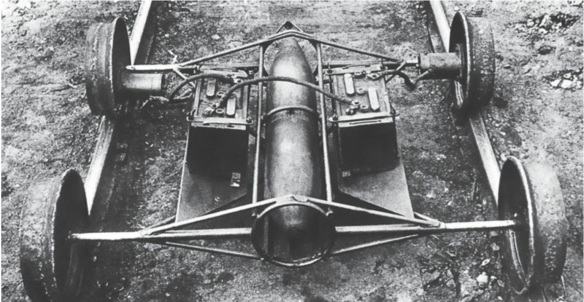The actual physical destruction of the tracks is not desirable when one intends to use them for one’s own trains, notably during the phase of an advance into enemy territory, which of course is not the case for guerrilla forces who do not operate trains. In the 1930s the Russian Army perfected a type of rail torpedo capable of destroying, or at least derailing, an enemy train. Hence the value of safety wagons at the front of trains.
Soviet ZhDT-3 rail torpedo, designed in the Podolsk factory in 1938. This simple, cheap `fire and forget’ device could cause considerable damage with its 100kg (220lb) explosive charge, launched at 50km/h (30mph) with a range of some 10km (6 miles). Although five examples of this device were issued to each armoured train in 1941, it is not known whether any were actually used in action. Its principal tactical drawback would have been that in `Barbarossa’, the Germans attacked using tanks, whereas the rail torpedo was most useful against enemy railway traffic, armoured or not, using the Russian broad gauge.
Armoured Rail Torpedo Projects by Louis Gregori
Detail from Patent No 350.169, submitted on 28 May 1904, granted on 13 September 1904.
In 1904, this inventor proposed a `land torpedo’, inspired by naval torpedoes, propelled by a motor preferably powered by compressed air, and protected from rifle fire by a metal casing. The armament consisted of four `warheads’, which from the patent illustration appear to be large-calibre artillery shells with nose-mounted impact fuzes, covering four planes and intended to inflict all-round damage: to track, stations, platforms, enemy trains etc. The first shell exploding when its nose fuze struck a target – most likely the front one but one of the others could be activated if the enemy derailed the device – would then set off the remaining shells.
